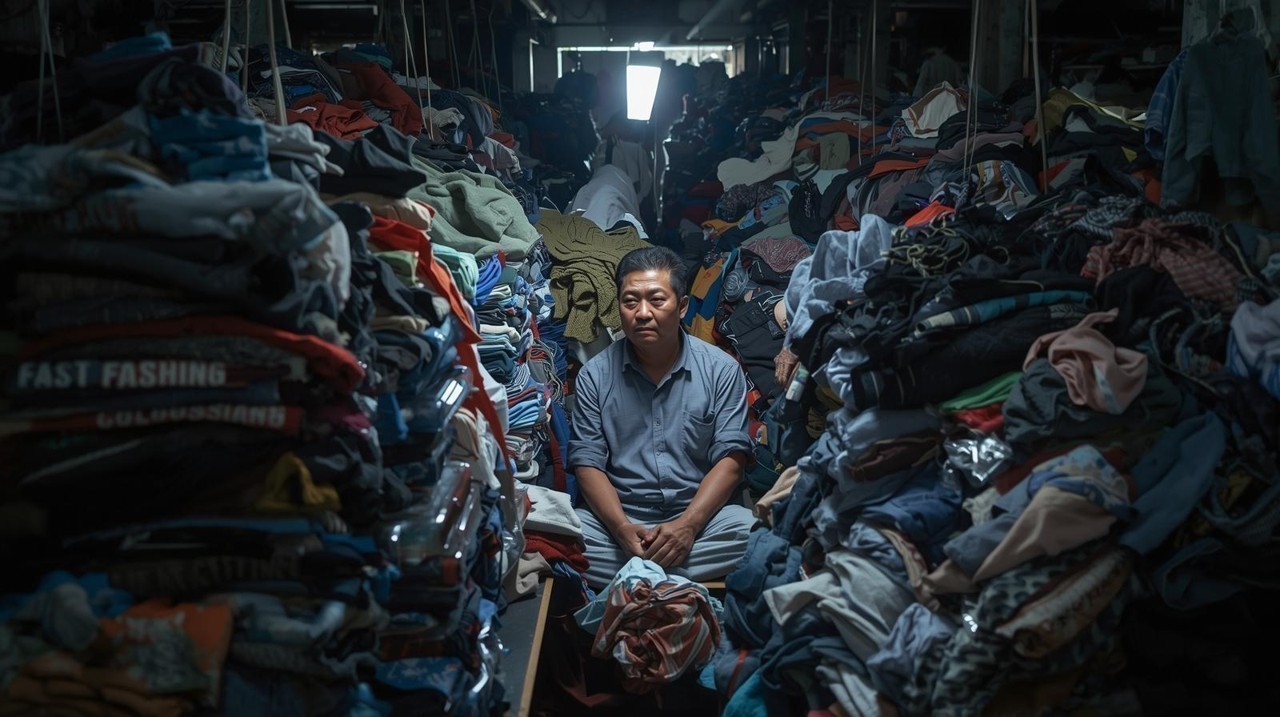
Post by : Soumya Jit
Fast fashion has revolutionized the clothing industry by providing trendy, affordable garments at unprecedented speed. Brands like Zara, H&M, and Shein have made it possible for consumers to access the latest styles almost instantly. However, behind the glamour of cheap, fast-moving clothing lies a harsh reality—one that affects workers, communities, and the environment. Understanding the social and environmental costs of fast fashion is crucial for making conscious choices as a consumer.
Fast fashion is one of the most polluting industries globally, contributing heavily to climate change, water pollution, and waste.
The fashion industry accounts for 10% of global carbon emissions, more than international flights and maritime shipping combined.
Constant production cycles, transportation of goods, and energy-intensive manufacturing increase the industry’s carbon footprint.
Producing a single cotton t-shirt can use up to 2,700 liters of water.
Textile dyeing releases toxic chemicals into rivers, harming aquatic life and contaminating drinking water in many countries.
Fast fashion encourages frequent purchases and disposability, resulting in millions of tons of clothing waste annually.
Most discarded clothes end up in landfills or incinerators, taking decades to decompose.
The environmental toll of fast fashion highlights the urgent need for sustainable alternatives and responsible consumption.
The human cost of cheap, fast-moving garments is equally alarming.
Many garments are produced in developing countries where labor laws are weak or poorly enforced.
Workers, often women and children, face low wages, long hours, and unsafe working conditions.
Sweatshops remain a significant concern, with limited access to workers’ rights and unionization.
Poorly regulated factories often lack basic safety measures, exposing workers to accidents, chemical exposure, and respiratory issues.
Notable incidents, such as the Rana Plaza collapse in Bangladesh, revealed the devastating human consequences of unsafe garment production.
Fast fashion perpetuates a cycle where big brands profit immensely while workers in supply chains remain underpaid.
Local economies often struggle to compete with cheap imports, impacting small-scale textile artisans.
These social costs emphasize that cheap fashion comes at a human price, often hidden from the consumer.
Fast fashion also affects consumers psychologically:
Overconsumption: Constant exposure to trends encourages people to buy more than needed.
Unsustainable Mindset: The focus on disposability fosters a “wear once, discard” culture.
Financial Strain: Frequent purchases of low-cost items can cumulatively impact personal budgets.
Awareness of these effects can encourage more mindful purchasing habits.
While fast fashion dominates the market, there are ways to mitigate its social and environmental impact:
Choose Quality Over Quantity: Invest in durable, timeless pieces instead of fleeting trends.
Support Ethical Brands: Opt for companies with transparent supply chains and fair labor practices.
Buy Secondhand: Thrift stores, resale apps, and vintage shops reduce demand for new production.
Recycle and Upcycle: Donate old clothes, repurpose textiles, or use recycling programs offered by brands.
Educate and Advocate: Awareness campaigns and consumer advocacy can push brands toward sustainability.
Small changes in buying habits collectively contribute to a more sustainable and ethical fashion industry.
Policy changes and corporate responsibility are critical in addressing fast fashion’s impact:
Governments can enforce stricter labor laws, environmental regulations, and supply chain audits.
Brands can adopt circular fashion models, sustainable materials, and transparency initiatives.
International collaborations can create standards for ethical production and environmental accountability.
These measures are essential to transform fast fashion from a destructive industry into a responsible, sustainable one.
The fast fashion industry may offer convenience and affordability, but its social and environmental costs are staggering. From exploited workers to polluted rivers and overflowing landfills, the consequences are far-reaching. Consumers, corporations, and governments all play a role in shaping a more sustainable future for fashion. By making ethical choices, supporting sustainable brands, and advocating for stronger regulations, we can reduce the dark side of fast fashion and create a fashion industry that values people and the planet.

Wear It, Train Smarter — How Smart Sportswear Is Becoming Your Next Virtual Coach
Dive into AI-driven smart sportswear — how sensor-embedded garments are revolutionizing workout feed

The Green Fitness Revolution: How Eco-Conscious Workouts Are Shaping the Future of Health and Planet
Discover how sustainable fitness is revolutionizing 2025 — from green gyms and recycled workout gear

Inside the Global Movement Where Science, Technology, and Self-Discipline Meet to Redefine Human Potential
Explore the 2025 biohacking boom — how people are using science, nutrition, and tech to enhance slee

Building Strength That Lasts a Lifetime: How Functional Training Keeps You Fit Beyond 40
Discover how functional fitness helps you maintain strength, balance, and energy after 40 — the key

Beyond the Gym: How Training the Mind Is Becoming as Essential as Training the Body
Explore how mind-body workouts are transforming wellness in 2025 by combining mental clarity, emotio

How Japan’s 3×3 Walking Formula Is Transforming Global Fitness Routines in 2025
Discover Japanese interval walking — a 20-minute alternating pace routine that boosts metabolism, he

How TikTok’s Great Lock-In Is Inspiring People to Build Healthier Habits Before the Year Ends
Discover how TikTok’s “Great Lock-In” trend is motivating people worldwide to focus on health, fitne

From Couch to Café Easy Ways to Style Knits and Loungewear for Any Occasion
Discover how to style knits and loungewear for any occasion Stay cozy confident and stylish from you

UE Dubai Students Shine at COP30 Simulation in Cairo, Showcasing Global Leadership in Climate Policy
University of Europe for Applied Sciences Dubai (UE Dubai) have taken centre stage at the COP30

Signs Your Gut Health May Be Slowing Your Weight Loss
Poor digestion can slow weight loss Learn the key signs your gut may be affecting metabolism and how

Keto Friendly Fruits Top 10 Low Carb Fruits for Weight Loss Success
Discover 10 keto friendly low carb fruits that support weight loss boost energy and keep your die

Rajvir Jawanda Life Career Music Hits & Tragic Accident Explained
Discover Rajvir Jawanda s journey from police aspirant to Punjabi music star his hits acting career

Karwa Chauth 2025 Date Rituals Legends and Modern Celebrations
Discover Karwa Chauth 2025 date rituals legends and modern celebrations highlighting love devotion a

DGHS Enforces No Cough Syrup Rule for Infants Urges Caution for Kids Under Five
DGHS bans cough syrup for infants and urges caution for kids under five to prevent health risks and

From Flying Taxis to Autonomous Delivery Dubai s Smart Transport Revolution
Explore Dubai s smart transport future with flying taxis autonomous vehicles and delivery drones sha